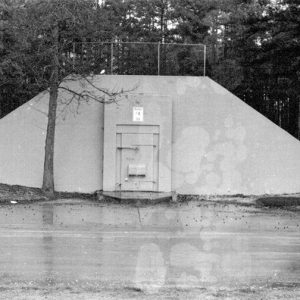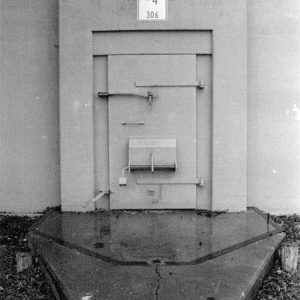calsfoundation@cals.org
Maumelle Ordnance Works Bunker No. 4
Maumelle Ordnance Works Bunker No. 4, located at 4 Willastein Drive in Maumelle (Pulaski County), is a reinforced concrete structure built in 1942 to store picric acid and ammonium picrate produced to create explosives during World War II. It was listed on the National Register of Historic Places on May 24, 2006.
The U.S. War Department approved the contract with the Cities Service Defense Corporation on July 15, 1941, to construct a plant to produce picric acid and ammonium picrate to be used in American weapons in World War II on 7,614 acres near West Marche (Pulaski County). Construction began on September 2, 1941, and by March 29, 1942, the first ammonium nitrate manufacturing facility began production. The Maumelle Ordnance Works (MOW) was essentially finished by May 25, 1942.
Along with the many manufacturing and supply buildings, the Maumelle Ordnance Works held twenty-one storage bunkers. Each of them was made of reinforced concrete and mounded with earth to help contain any explosions. The bunkers were sixty-one feet long and twenty-seven feet wide with rounded roofs that had an inside radius of thirteen feet and five inches. According to the National Register nomination, each of the bunkers had a “lightning rod protection system, ventilator stack with fusible link control, membrane waterproofing, indirect lighting by reflective mirror and floodlights, steel doors, and concrete pavement adjacent to entrance for loading and unloading.”
Production at the Maumelle Ordnance Works essentially stopped on August 15, 1945, and by February 28, 1946, decontamination of the site was completed. The federal government continued to own the site, and the storage bunkers were sometimes used to hold in-transit bulk explosives. The site was declared surplus on June 20, 1960, and eventually was sold to the Maumelle Land Development Corporation, which created Maumelle New Town. Maumelle became a city in July 1985.
Three of the storage bunkers survive, facing Lake Willastein. The City of Maumelle uses Bunker No. 3 for a variety of purposes, and another bunker had its front and sides removed to create a pavilion. Bunker No. 4 was preserved as a reminder of the city’s origins. “The development of the land for MOW led to the eventual residential settlement in Maumelle,” the National Register states. “This structure is a significant part of the city’s history in terms of its contributions to the development of Maumelle and local involvement in the war effort.”
For additional information:
Collins, David. “Sandwiching in History—06/01/2018—Maumelle Ordnance Works Bunker #4.” Arkansas Historic Preservation Program. https://www.arkansasheritage.com/arkansas-preservation/programs/tours (accessed February 28, 2024).
Hoganson, John James. “Maumelle Ordnance Works: From Wartime to the New Town.” MA thesis, University of Arkansas at Little Rock, 2020.
James, Elizabeth A. “Maumelle Ordnance Works Bunker #4.” National Register of Historic Places registration form. On file at Arkansas Historic Preservation Program, Little Rock, Arkansas. Online at http://www.arkansaspreservation.com/National-Register-Listings/PDF/PU8364.nr.pdf (accessed December 21, 2020).
Mark K. Christ
Central Arkansas Library System
 Historic Preservation
Historic Preservation World War II through the Faubus Era, 1941 through 1967
World War II through the Faubus Era, 1941 through 1967 Maumelle Ordnance Works Bunker No. 4
Maumelle Ordnance Works Bunker No. 4  Maumelle Ordnance Works Bunker No. 4
Maumelle Ordnance Works Bunker No. 4  Maumelle Ordnance Works Bunker No. 4
Maumelle Ordnance Works Bunker No. 4 




Comments
No comments on this entry yet.